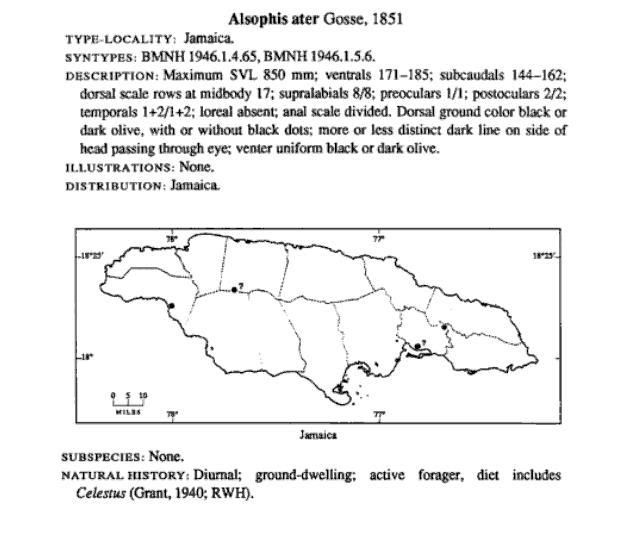|
|
Post by Melanie on Apr 10, 2008 10:12:44 GMT
The Black Racer (Alsophis ater) was endemic to Jamaica. It disappears in the 1940s after deforestation and the predation by introduced mongooses. After the found of a skin in the early 1970s there is a faint hope that it might have survived.
|
|
|
|
Post by Melanie on Apr 10, 2008 10:16:14 GMT
Also known as Jamaican Tree-snake
|
|
|
|
Post by another specialist on Apr 10, 2008 14:41:28 GMT
Assessment Information Red List Category & Criteria: CR B1+2ce ver 2.3 (1994) Year Assessed: 1996 Annotations: Out of date Assessor/s: Gibson, R. History: 1994 - Endangered (Groombridge 1994) www.iucnredlist.org/search/details.php/940/all |
|
|
|
Post by another specialist on Sept 1, 2008 16:18:55 GMT
 Caribbean Amphibians and Reptiles By Brian I. Crother, Albert Schwartz |
|
|
|
Post by another specialist on Sept 1, 2008 16:19:32 GMT
 Catalogue of the Snakes in the British Museum (Natural History) ... By British Museum (Natural History). Dept. of Zoology, British Museum Natural History, George Albert Boulenger |
|
|
|
Post by another specialist on Sept 1, 2008 16:22:20 GMT
 Amphibians and Reptiles of the West Indies By Albert Schwartz, Robert W. Henderson |
|
|
|
Post by sebbe67 on Jul 4, 2009 11:38:07 GMT
Nevertheless, Gosse’s (1851) description of Alsophis ater being the “most common Ophidian reptile in Jamaica” (1844-1846) is probably accurate, and specimens were collected as late as 1920-1930 (BMNH;USNM). Since then, only a single shed skin has been collected (early 1970’s; R. I. Crom-bie, pers. comm.). Although the disappearance of A. ater may be attributable to various factors, species of Alsophis are known to be sensitive to Herpestes introductions (see below), and Jamaica has har-bored mongooses longer than any otherisland in the West Indies academic.uprm.edu/publications/cjs/VOL28/P001-010.PDF |
|
|
|
Post by simontonge on Dec 30, 2011 10:34:43 GMT
This is a photo of a specimen of Alsophis ater taken in the Natural History Museum in London in 1981 by William Oliver that I thought might be of interest to forum readers. I don't think this species has been illustrated here before. Attachments:
|
|
|
|
Post by Peter on Dec 30, 2011 10:42:21 GMT
This is certainly of interest to me and I'm sure indeed also to other forum readers. Thanks for sharing. Always great to see pictures of museum specimens!
|
|
|
|
Post by simontonge on Jan 2, 2012 15:24:18 GMT
Hi Peter Yes I think that documenting the surviving specimens of extinct species is important and it is certainly interesting. Artistic reconstructions are valuable and have their place but they can't beat the real thing! It is a shame that sometimes photos of specimens are put on this forum but the provenance of them isn't also given. I think contributors should always try to state at least where and when the photo was taken even if they don't know anything else about it.
Incidentally I think the specimen illustrated here may be one of the two syntypes of this species.
Happy New Year to all!
|
|
|
|
Post by surroundx on Sept 16, 2012 6:22:38 GMT
|
|
|
|
Post by Sebbe on Dec 14, 2016 19:18:32 GMT
|
|
|
|
Post by Peter on Dec 27, 2016 17:15:16 GMT
The links are broken. Does anyone remember which paper this was? EDIT: found on Branden's website: Henderson, Robert W. (1992). Consequences of predator introductions and habitat destruction on amphibians and reptiles in the post-Columbus West Indies. Caribbean Journal of Science 28: 1-10. |
|